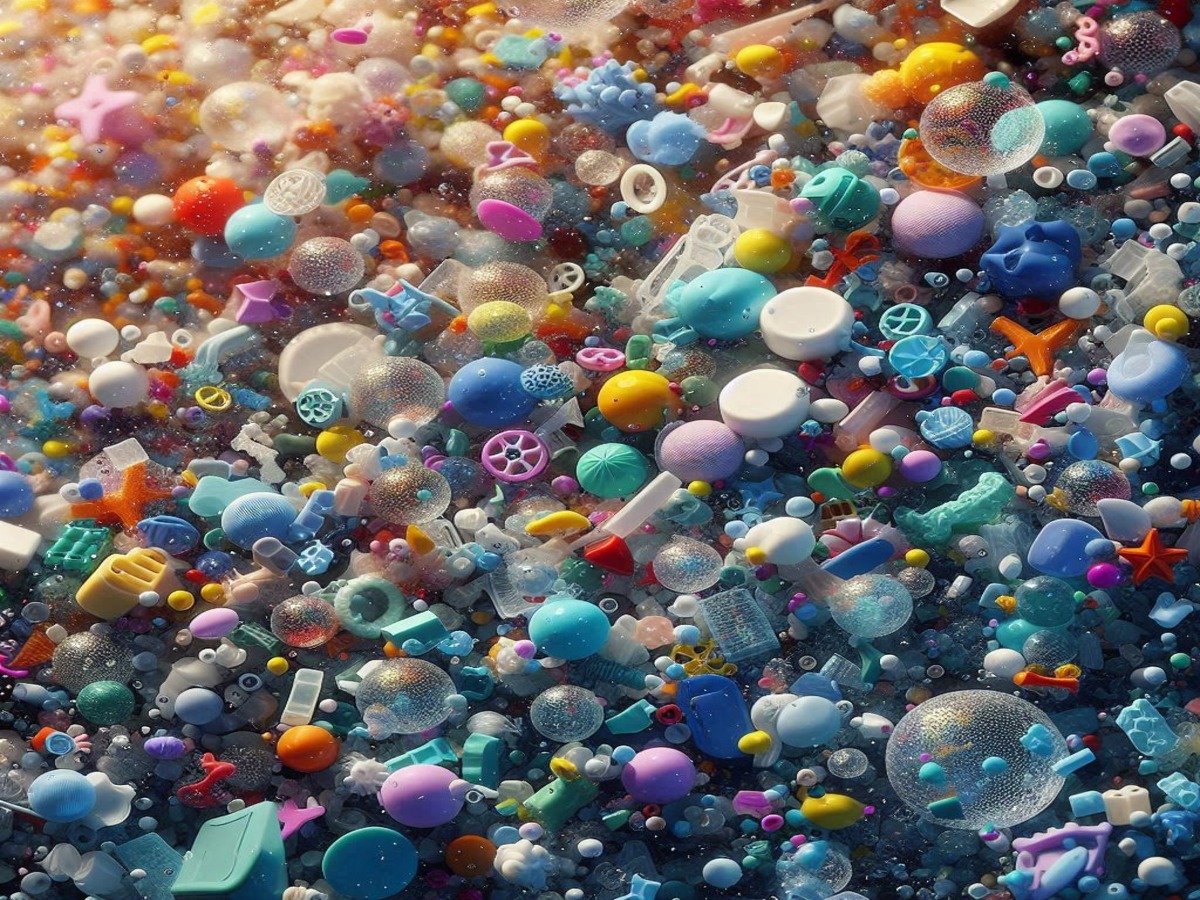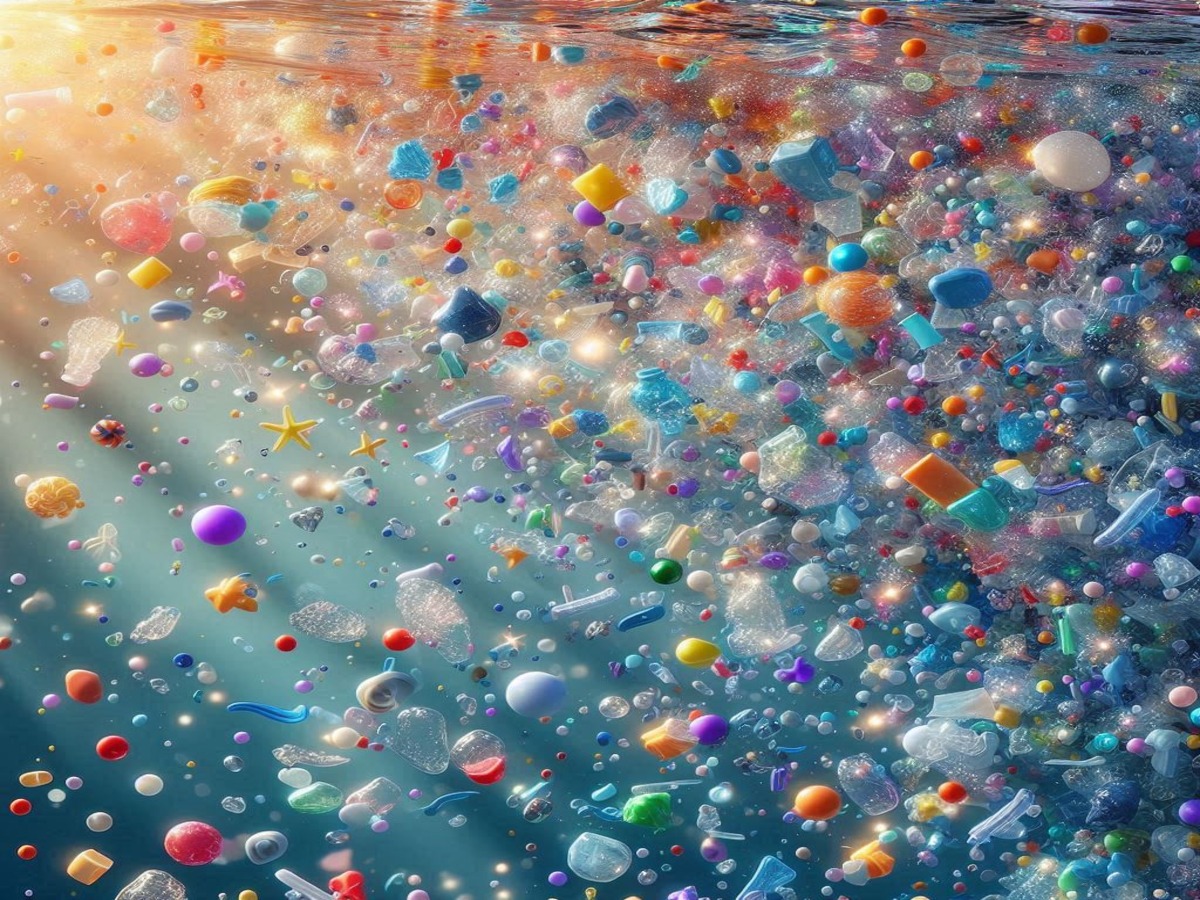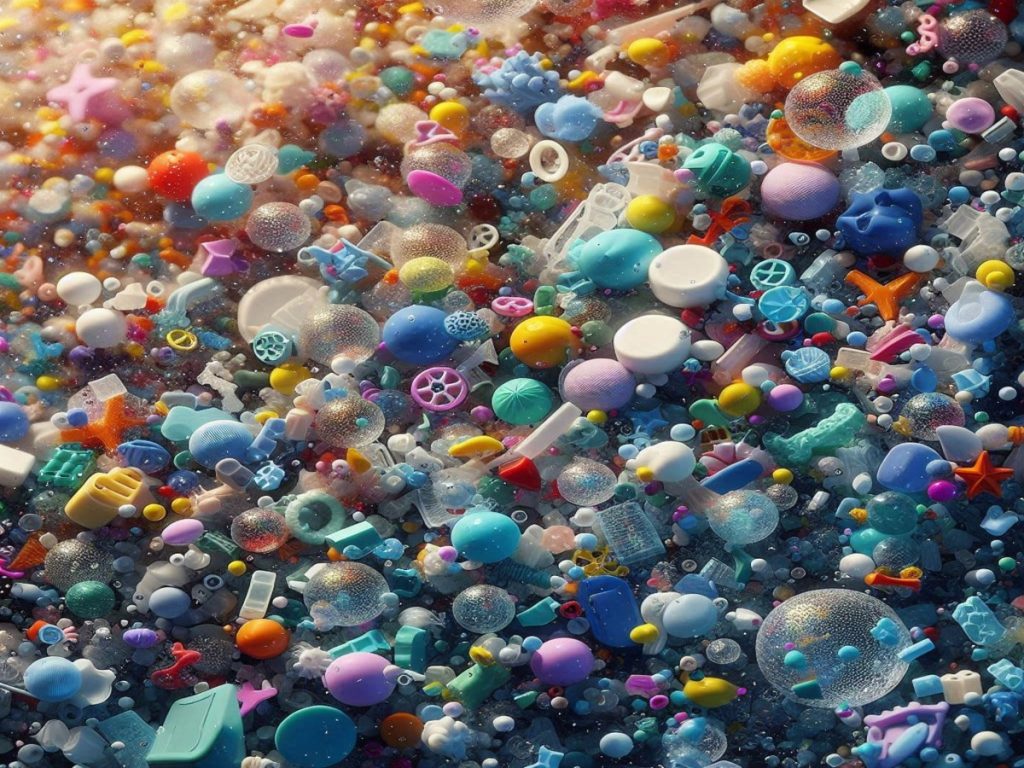Microplastics are everywhere—in the water you drink, the food you eat, and even the air you breathe. They’ve infiltrated our oceans, our homes, and our bodies, raising serious concerns about their impact on our health and the environment.
But what exactly are these tiny invaders, and how can you protect yourself and the environment from them?
In this article, we’ll break down what microplastics really are, how they affect you, and share practical tips to help you keep them at bay and keep the environment safe.
Let’s get into it!

What are Microplastics?
You might have heard this term thrown around, but what does it really mean? Simply put, microplastics are tiny plastic particles, usually less than 5 millimeters in size—about the size of a sesame seed.
They come from various sources, including larger plastic items that break down over time, as well as from products like cosmetics and clothing.
But don’t let their size fool you. Despite being microscopic, microplastics have a massive impact on our environment and health. Microplastics and their components are everywhere, from the deepest parts of the ocean to the food on your plate. You might be surprised to learn just how pervasive they are.
Where Do Microplastics Come From?
Microplastics originate from a variety of sources. One of the primary sources is the degradation of larger plastic items, such as bottles, bags, and packaging. Over time, these larger plastics are broken down by sunlight, wind, and water into smaller and smaller particles, and before you know it, we have microplastics floating in our water and oceans.
Then there’s the stuff we might not think about—cosmetics. Many beauty and personal care products, like exfoliating scrubs, toothpaste, and even some makeup, contain tiny plastic beads designed to improve texture or provide a scrubbing effect. Once these products are washed down the drain, they make their way into water systems and, eventually, into the environment.
Clothing also plays a part. When we wash clothing made from polyester, nylon, or acrylic, microfibers are released into the water supply. These microplastics in water then travel through treatment plants and into rivers, lakes, and oceans, where they accumulate over time.
And let’s not forget the air. Microplastics from things like tire wear, paint, and synthetic fabrics can become airborne and settle back down in water or be inhaled by us.
Microplastics in Water

Microplastics in the marine environment are a growing concern because they are practically impossible to remove once they enter ecosystems.
You might be surprised to know that microplastics are turning up everywhere—from your local streams to the deepest parts of the ocean. You’ll find them in water, whether it’s in your tap water, bottled water, or even in the ocean.
Studies have shown alarming amounts of microplastics in our seas, affecting marine life and ecosystems, proving that no part of our planet is untouched by this issue.
These particles are so small that water treatment plants often can’t catch them, so they end up polluting our lakes, rivers, and seas.
The consequences are huge. Microplastics in the ocean can be mistaken for food by marine creatures, such as fish, seabirds, and even plankton, which means they end up in fish and other seafood, ultimately ending up on our dinner plates. When we eat these fish, we might be eating microplastics too, which could be bad for our health.
Microplastics in Food
But it’s not just the ocean that’s impacted. Microplastics are sneaking into our food, too. They can hitch a ride on fruits and veggies or even get mixed into processed foods. You can even find microplastics in teabags!
We’ve already established that marine creatures, like fish and shellfish, often mistake these tiny plastic particles for food. Once they eat them, these microplastics can end up in their bodies. And guess what? When we eat seafood, we might be munching on these microplastics too. It’s a cycle that’s hard to break, especially with the increasing pollution in our waters.
But it’s not just seafood. Microplastics in water can affect crops too. If water contaminated with microplastics is used for irrigation, those tiny particles can end up in the fruits and vegetables we eat. Even if you’re not eating seafood, you might still be exposed through your food.
Studies have also shown that microplastics can settle on crops, especially those grown near polluted areas. This means that when you bite into that fresh salad, you could be getting a side of microplastics without even knowing it.
Microplastics in Cosmetics
Now here’s a source of microplastics we often overlook: your cosmetics. Microplastics are increasingly found in beauty and personal care products. You might not realize it, but those tiny beads in exfoliating scrubs and some facial cleansers are actually microplastics. You’ll often see them labeled as “polyethylene” or “polypropylene.”
These microplastics in cosmetics are designed to help scrub your skin or add texture to products. But here’s the catch: when you wash these products off, they don’t just disappear. They go down the drain and end up in our water systems. From there, they can flow into rivers, lakes, and oceans, contributing to the microplastics in the marine environment.
The impact is far-reaching. Marine life can mistake these microplastics for food, leading to microplastics in fish and other sea creatures. When we eat seafood, we might be ingesting these tiny plastic particles too, which isn’t great for our health.
You see, everything is intertwined into this continuous chain of events.
Microplastics in Air
You might think of microplastics mostly in water or food, but they’re also floating around in the air we breathe.
Microplastics can become airborne through various means. When plastic products like bags or bottles break down, they create tiny particles that can be carried by the wind. Even things like tire wear and synthetic clothing contribute to microplastics in the air.
Studies have shown that microplastics in the environment can be found in urban areas, where traffic and industrial activities contribute to their presence. This means that every time you take a deep breath, you could be inhaling these tiny particles. Imagine the implications for your health, especially if you live in a city with high pollution levels!
These airborne particles can also settle on surfaces, including your food and drinking water, which links back to microplastics in food and water. They’re also known to enter our lungs, which is pretty alarming. Research shows that breathing in microplastics could potentially harm our respiratory health.
How Do Microplastics Affect Our Health?
Microplastics might sound like a small problem, but they can have some serious health impacts. While research is still ongoing, early studies suggest that microplastics in food and water may pose serious health risks. These tiny particles can carry harmful chemicals, which can leach into our bodies when ingested.
1. Stomach issues:
When we eat seafood, for instance, we could be munching on fish that have swallowed microplastics floating around in the ocean. Studies have shown that these little bits of plastic can carry nasty chemicals that might mess with our hormones and immune systems.
Research from Environmental Science & Technology suggests that microplastics can cause inflammation and other health issues in animals, which makes you wonder what they might do to us.
2. Breathing troubles:
And it’s not just what we eat. Breathing in microplastics from the air can be a problem too. A study published in The Lancet even found microplastics in human lung tissue! That’s pretty alarming and shows we need to pay attention to what’s going into our bodies.
Breathing in microplastics can settle in our lungs, potentially leading to irritation or inflammation. This can contribute to respiratory issues like asthma, making it more than just a minor inconvenience.
While research is still ongoing, the Journal of Hazardous Materials shows some possible links between microplastics and respiratory as well as cardiovascular problems.
3. Toxic effects:
Another concern is that microplastics are known to attract and absorb toxins from the environment, such as pesticides, heavy metals, and industrial chemicals. When these contaminated microplastics are ingested or inhaled, they can introduce these toxins into the body.
This exposure can potentially lead to various health issues, including endocrine disruption and other toxic effects.
4. Immune system effects:
Microplastics might also impact your immune system. The body’s reaction to these foreign particles could lead to inflammation, which might weaken your immune system and make you more vulnerable to other illnesses.
5. Long-term effects:
While we’re still figuring out all the long-term effects of microplastics, we know they’re harmful. Ongoing research will help us understand their full impact, but reducing exposure by avoiding products with microplastics and supporting anti-plastic initiatives can help protect your health and the environment.
The Effects of Microplastics on the Environment
Microplastics are causing some serious trouble for our environment, and it’s a bigger deal than you might think.
Here’s a closer look at how they’re affecting our planet:
1. Impact on marine life:
Microplastics in the ocean are wreaking havoc. Sea creatures, from tiny plankton to big fish, often mistake these bits of plastic for food. Eating microplastics can hurt or even kill them.
Plus, these particles can carry harmful chemicals that get passed up the food chain, affecting more and more marine life.
2. Disruption of ecosystems:
Microplastics aren’t just floating around; they’re causing problems on the seafloor and in freshwater habitats. They can cover coral reefs, harm underwater plants, and mess with the delicate balance of these ecosystems.
3. Soil contamination:
Microplastics aren’t just an ocean problem; they’re found in soil as well. They can come from agricultural runoff, sewage sludge, and degraded plastic products.
In soil, microplastics can impact plant health by interfering with root growth and soil structure, potentially affecting food crops and terrestrial ecosystems.
4. Air pollution:
Believe it or not, microplastics are even in the air. As plastics break down, tiny particles become airborne and can be breathed in. This not only contributes to pollution but might also impact our health in ways we’re still figuring out.
5. Long-term persistence:
One of the most concerning aspects is that microplastics don’t just disappear. Unlike organic materials, microplastics don’t break down fully. They stick around for hundreds of years, causing ongoing damage to our environment and wildlife.
6. Climate change:
The production and breakdown of plastics contribute to greenhouse gas emissions. As microplastics accumulate in the environment, they can exacerbate climate change by affecting natural processes, such as carbon storage in oceans and soils.
How Can You Avoid Microplastics?
Given the widespread presence of microplastics, avoiding them entirely might seem impossible.
However, to reduce your exposure and minimize your contribution to the problem, here’s a handy list of tips to help you steer clear of these tiny troublemakers and keep yourself and the planet in better shape:
1. Opt for microplastic-free sea salt:
When choosing salt, go for options labeled as microplastic-free. Regular table salt often contains microplastics, so check out brands like Maldon, which are less likely to have these tiny particles.
2. Avoid microbeads in cosmetics:
Before buying skincare products, look at the EWG microplastics in cosmetics list to avoid those with microbeads. Instead, choose products with natural ingredients like sugar or salt for exfoliation.
Look for products that are marked as microplastic-free. You can also find lists of such products and more info on websites like Beat the Microbead, which helps you choose plastic-free cosmetics.
3. Cut down on plastic use:
Try to use reusable bags, bottles, and containers whenever possible. Single-use plastics can end up breaking down into microplastics that find their way into our food and water. Switch to eco-friendly alternatives and make a difference with every choice.
4. Use a Guppyfriend bag:
Wash synthetic clothes in a Guppyfriend bag or similar bags to capture microplastic fibers and prevent them from entering the water system. A Guppyfriend bag is a special type of laundry bag designed to capture microplastic fibers that are shed from synthetic clothing during washing.
5. Support plastic reduction initiatives:
Get involved in local clean-up efforts or support policies aimed at reducing plastic waste. Every little bit helps in keeping microplastics out of our oceans and environment.
6. Use a water filter:
Water is another area to focus on. Use a good water filter that can reduce microplastics. Studies show that microplastics in water can easily end up in our glass, so filtering it can make a difference.
Bottom Line
Microplastics are sneaking into our lives in ways we might not even realize—floating in our water, showing up in our food, and drifting through the air. It’s a big deal because these tiny bits of plastic can have a huge impact on our health and the environment.
But here’s the good news: we can make a difference.
By choosing products wisely, cutting down on plastic, and being smart about what we eat, we’re taking steps toward a cleaner, healthier world. So let’s stay mindful and act now, because every small choice we make can lead to big changes.
